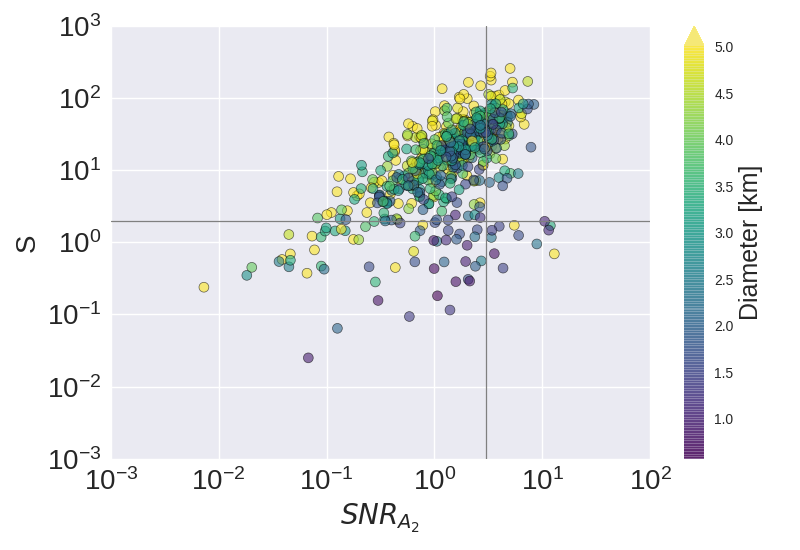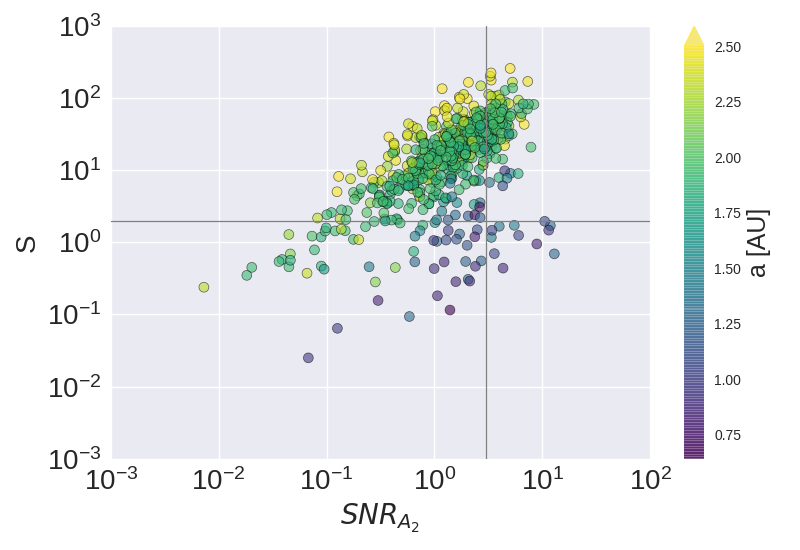Computing the Yarkovsky effect for asteroids in Gaia DR3
- 1Astronomical Observatory Institute, Faculty of Physics, A. Mickiewicz University, Słoneczna 36, 60-286 Poznań, Poland
- 2Minor Planet Center – Center for Astrophysics, Harvard Smithsonian, 60 Garden St., MS 15, Cambridge (MA), USA)
- 3Université Côte d’Azur, Observatoire de la Côte d’Azur, CNRS, Laboratoire Lagrange, France
Long-awaited, Gaia Data Release 3 was published 2022, on June 13th and contains ultra-precise astrometric measurements for over 150 000 small bodies in the Solar System (Tanga et al. 2022). Compared to Gaia DR2, this release will contain a longer observational arc which is crucial in finding subtle non-gravitational forces, such as the Yarkovsky effect (A2 or da/dt). The main consequence of this perturbation is a secular drift of the semi-major axis (a) of small bodies.
The influence of Gaia data in the determination of the Yarkovsky effect has already been proven (Gaia Collaboration, Spoto et al. 2018, Spoto et al. 2019, Dziadura et al. 2022, Tanga et al. 2022). This effect is now quite well known for Near-Earth Asteroids but still remains hard to detect especially for objects in the Main Belt.
So far we have tried to detect the Yarkovsky effect for all NEAs, Mars Crossers and MBA objects available in Gaia DR2 (606 objects). We used the new weighting scheme (Spoto et al., in preparation) which contains weights for observations depending on: the observatory code, the stellar catalogue used for reduction, the epoch of the observations, and a given magnitude class. We present our result in Fig. 1. The S value represents S = A2(this work)/A2(expected) where the expected value is determined as in Spoto et al. (2015). There are 13 asteroids which meet the conditions of S > 2 and SNR > 3 (green points), all of them are NEAs. In Fig. 2 and 3 we plotted the same asteroids in dependency of diameter (d) and semimajor axis respectively. As expected we conclude that even with Gaia DR2, this effect still remained difficult to detect for Mars Crossers and MBAs.
We present preliminary results obtained from Gaia DR3. We selected all the objects with a diameter < 5 km and we compared our detected value to the expected value determined based on the physical and orbital parameters of the objects.
Acknowledgements
This work presents results from the European Space Agency (ESA) space mission Gaia. Gaia data are being processed by the Gaia Data Processing and Analysis Consortium (DPAC). Funding for the DPAC is provided by national institutions, in particular the institutions participating in the Gaia MultiLateral Agreement (MLA). The Gaia mission website is https://www.cosmos.esa.int/gaia. The Gaia archive website is https://archives.esac.esa.int/gaia.
The research leading to these results has received funding from the Ministry of Science and Higher Education of Poland in the years 2018/2022, as a research project under the ‘‘Diamond Grant’’ program, grant number 0062/DIA/2018/47.
References
Tanga et al. 2022, Gaia Data Release 3: the Solar System Survey, 2022, submitted to A&A
Gaia Collaboration, Spoto et al. 2018: Gaia Data Release 2: Observations of Solar System Objects, 2018, A&A
Spoto, F., Tanga, P., & Carry, B. (2019, September). Direct detections of the Yarkovsky drift with Gaia DR2. In EPSC-DPS Joint Meeting (p. 182)
Dziadura, K., Oszkiewicz, D., & Bartczak, P. (2022). Investigating the most promising Yarkovsky candidates using Gaia DR2 astrometry. Icarus, 115040
Spoto, F., Milani, A., & Knežević, Z. (2015). Asteroid family ages. Icarus, 257, 275-289
Del Vigna, A., Faggioli, L., Milani, A., Spoto, F., Farnocchia, D., & Carry, B. (2018). Detecting the Yarkovsky effect among near-Earth asteroids from astrometric data. Astronomy & Astrophysics, 617, A61

Figure 1. S parameter as a function of signal to noise ratio SNRA2. Green circles represent accepted values (SNRA2 > 3 and S < 2) - consistent with expected value determined, blue circles are marginal cases (2.5 < SNRA2 < 3 and S < 2), and red are values with SNRA2 > 3 or S > 2.5. Horizontal line represents S = 2. The Vertical line represents SNRA2 = 3. (Del Vigna et al. 2018)

Figure 2. The Color bar represents the dependence of the asteroid's diameter. If the diameter was not available in JPL it was calculated from the absolute magnitude. Axes as in Figure 1.

Figure 3. The Color bar represents the dependence of the asteroid's semimajor axis. Axes as in Figure 1.
How to cite: Dziadura, K., Spoto, F., Oszkiewicz, D., Carry, B., Bartczak, P., and Tanga, P.: Computing the Yarkovsky effect for asteroids in Gaia DR3, Europlanet Science Congress 2022, Granada, Spain, 18–23 Sep 2022, EPSC2022-649, https://doi.org/10.5194/epsc2022-649, 2022.

